The Nissan Altima debuted over 30 years ago ... and that says something. Any vehicle with this kind of staying power obviously has been doing something right.
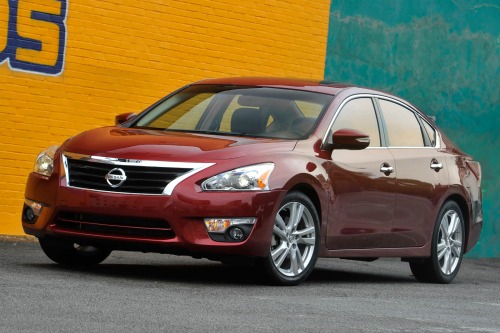
And in today's very high-priced used car market, many shoppers are now looking for "older" models that have aged well as a way to save significant dollars. And the Nissan Altima has, for the most part, been one of those models, and with careful shopping, can be a viable and more economical option at this time.
Consumer Reports and J.D. Power often provided insights into vehicle reliability based on surveys and data collected from owners. In their assessments, the Altima typically received average to above-average reliability ratings for its segment, indicating that many owners found it dependable.
Data from actual owners shows that a well-maintained Altima can last between 250,000 and 300,000 miles. And it's not totally uncommon for this model to go beyond 300,000 miles. But again, the key is "well-maintained".
So here, ...
- We'll do an overview of some earlier Nissan Altima generations, specifically those covering the 2002 - 2018 model years.
- Then we'll list possible mechanical issues that have been reported by some owners for each generation so they can be checked before buying one today.
- And then we'll summarize the overall pros and cons of an older Altima worth consideration for potential buyers today.
Fifth Generation Nissan Altima (2013 - 2018)
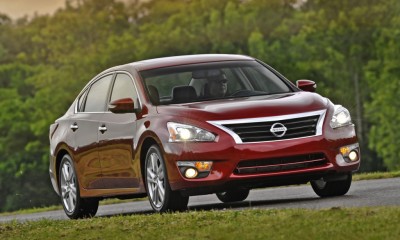
While going head-to-head against the likes of the Honda Accord And Toyota Camry, the Altima's success is due to its combination of family-sedan-practicality with the handling and performance of a vehicle closer to those usually preferred by a driving enthusiast.
The fifth generation Altima brought various updates and changes, offering improvements in design, technology, and performance over its predecessor. This generation also marked Nissan's efforts to enhance fuel efficiency, cabin comfort, and safety features, aiming to remain competitive in the midsize sedan segment.
Its styling received a more modern and aggressive touch, featuring the signature V-Motion grille and a more streamlined profile. The interior was refined with better-quality materials and an emphasis on comfort and technology, including available features such as advanced infotainment systems, improved connectivity options, and enhanced driver-assistance technologies.
Engine options included a standard 2.5-liter four-cylinder engine and an optional V6 engine for higher trims. Transmission options often involved a continuously variable transmission (CVT) that aimed to optimize fuel economy.
The more significant year-to-year changes:
2013 Model Year: Improved fuel efficiency with the new Xtronic Continuously Variable Transmission (CVT). Enhanced interior quality and technology features, including available NissanConnect infotainment system. It should be noted, however, that this model year had higher incidents of CVT issues.
You May Also Like:
Do This For The Best Trade-In Price
The Truth About Wholesale And Trade-in Values
How To Get The Lowest Rate Car Loan
2014 Model Year: Minor updates focusing on feature availability across trim levels. Introduction of optional lane departure warning and blind-spot monitoring systems in higher trim levels.
2015 Model Year: Introduction of a Technology Package for higher trim levels, including NissanConnect with navigation, blind-spot monitoring, and other advanced safety features. Slight revisions to standard and optional equipment across trim levels.
2016 Model Year: Mid-cycle refresh with revised exterior styling, including new headlights, taillights, and front grille design. Introduction of Nissan's Safety Shield suite, offering forward collision warning, emergency braking, and adaptive cruise control in higher trims. Enhanced interior materials and available technology upgrades, such as the NissanConnect Services package.
2017 Model Year: Addition of Apple CarPlay and Android Auto smartphone integration in select trims or as part of available packages. Expanded availability of safety features across more trim levels. Minor adjustments to trim level equipment and options.
2013 - 2018 Nissan Altima Possible Mechanical Problems
The fifth generation Nissan Altimas generally earned a good reputation for reliability, but like any vehicle, they did experience some common issues reported by owners and identified through technical service bulletins (TSBs) or recalls. Here are mechanical problems that some owners encountered that should be checked before buying one today:
CVT Transmission Issues: Some drivers reported problems with the continuously variable transmission (CVT). Issues included transmission shuddering, hesitation, or jerking during acceleration. Nissan addressed some of these concerns through software updates or, in some cases, extended warranties to cover CVT-related problems.
Engine Issues: There were occasional reports of engine-related problems, such as excessive oil consumption in certain vehicles or issues with the engine's electronic control module (ECM) causing stalling or starting difficulties.
Suspension and Steering: Some owners reported issues with the suspension system, including noises from the front suspension or premature wear on suspension components. Steering problems like vibrations or looseness in the steering wheel were also reported in some cases.
Electrical Problems: A few owners experienced issues with the car's electrical systems, such as malfunctioning sensors, faulty ignition switches, or problems with the vehicle's electronics, causing issues with various components like the audio system, lights, or power windows.
It's importand to note that while these problems were reported by some owners, they were not prevalent across all vehicles. Also, regular maintenance and prompt attention to any symptoms may have helped mitigate potential issues in most vehicles.
Fourth Generation Nissan Altima (2007 - 2012)
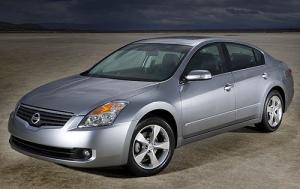
This generation is available in both sedan and coupe body styles with three trims: 2.5, 2.5 S and 3.5 SR. Powering the 2.5 models is a 2.5-liter four-cylinder engine with an output of 175 horsepower. The sedan comes with a continuously variable transmission (CVT), while the coupe can be found with either the CVT or a 6-speed manual transmission.
Under the hood of the 3.5 SR is a 3.5-liter V6 that pumps out a robust 270 horsepower, paired with the same transmission choices as the 2.5.
The more significant year-to-year changes:
2007 Model Year: Got a freshened styling and new standard safety features. The sedan was was made an inch shorter in wheelbase and an overall 2 inches shorter.
Front side airbags and curtain airbags became standard across all trims. Traction control also was made standard on 3.5 models and an antiskid system became an exclusive 3.5 model option. The navigation system was upgraded with a rearview camera and a wireless cell phone link became available as a new option.
Nissan introduced the Altima Hybrid, to be sold only in California and seven specific northeastern states. The Hybrid featured a four-cylinder engine with a CVT (continuously variable transmission) and an electric motor, the combination of which produced a total of 198 horsepower.
2008 Model Year: Antilock brakes (ABS) became standard across all Altima models. Splash guards and a Diversity Antenna were also added as standard features while XM satellite radio became available as an option.
The Nissan Altima Coupe, smaller in dimensions and still sportier in nature, was introduced. It was offered with the same powertrain choices as the sedan.
2009 Model Year: Only modest changes occurred in 2009, with base models getting several additional standard features, including power mirrors and a trip computer. And new stand-alone options were also added, including a sunroof and dual-zone climate control with rear vents.
2010 Model Year: Nissan refreshed the Altima's front fascia as well as added stability control as a standard feature. Also new was an upgraded sound system and a navigation system improved with a larger touchscreen and additional real-time satellite information, Bluetooth connectivity and digital music storage.
In addition, the 3.5 SE was renamed to the 3.5 SR and the manual transmission sedan was discontinued.
2012 Model Year: Dropped the Altima Hybrid model, minor feature availability revisions ... essentially unchanged.
2007 - 2012 Nissan Altima Possible Mechanical Problems
The fourth generation Altima generally had a good reputation for reliability, but like any vehicle, it experienced some commonly reported issues that should be checked today before purchase:
CVT Transmission Problems: One of the more notable issues involved the Continuously Variable Transmission (CVT), including transmission failure, jerking or shuddering during acceleration, and issues with the belt slipping. Nissan addressed some of these concerns through software updates, extended warranties, or, in some cases, replacements.
Steering Lock Failure: There were instances where the electronic steering lock mechanism malfunctioned, preventing the vehicle from starting. This issue led to a recall affecting several Altima models.
Engine Issues: Some owners reported excessive oil consumption in certain vehicles, which could lead to related problems if not monitored and addressed regularly. Additionally, there were occasional reports of premature wear or failure of engine components, though these were less common.
Suspension and Brake Problems: There were sporadic reports of premature wear on suspension components, leading to noises from the front suspension. Brake issues, such as premature wear on brake pads or rotors, were reported by some owners as well.
Electrical and Sensor Problems: Instances of electrical malfunctions or sensor issues, particularly related to the vehicle's electronics or sensors causing warning lights to illuminate prematurely, were reported by a few owners.
It's essential to note that these issues weren't universal across all vehicles, and many owners did not experience any major problems during ownership.
Third Generation Nissan Altima (2002 - 2006)
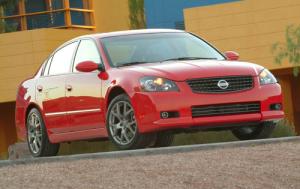
This generation is quite similar to the fourth generation version. When compared to its predecessor, however, it added about 6 inches in length, a stronger body and a new suspension.
It was also one of the most powerful family sedans at the time, equipped with either a 175-horsepower 2.5-liter four-cylinder engine or a 240-horsepower 3.5-liter V6 and was coupled with either a 5-speed automatic or 5-speed manual transmission.
Also during this production run, and for more serious driving enthusiasts, the Altima SE-R (2005 and 2006) is particularly appealing due to its additional power, firmer suspension and 6-speed manual transmission.
For those of you who may be interested in an older Altima, here's some of the more significant model changes to be aware of.
The more significant year-to-year changes:
2003 Model Year: Following a significant redesign in 2002, the 2003 model received only minor trim and equipment changes. The Altima 2.5 SL sedan became automatic-only, imitation-wood interior trim was introduced, as were heated seats and mirrors.
In addition, titanium-color interior accents were added to other models, the Sport Package for the 3.5 SE added a sunroof and rear spoiler, and a new Sport Plus Package added a premium audio system and xenon headlights.
The SE's Leather Package also added premium sound, a sunroof and heated seats, and a new SE Leather Sport Package added xenon lights and a rear spoiler.
2005 Model Year: The sporty Altima SE-R model was introduced. The SE-R was equipped with an athletic 260 horsepower V6 engine and would soon become very popular. All models received an updated interior trim and navigation was added as an optional feature.
2002 - 2006 Nissan Altima Possible Mechanical Problems
The third generation Nissan Altima also had some reported issues that owners encountered. Here are some of the common problems associated with this generation that should be included in a pre-purchase inspection:
Transmission Issues: Similar to later generations, the some third-gen Altima owners experienced problems with its automatic transmission, including the automatic transmission failing prematurely or experiencing slipping, which could lead to rough shifting or hesitation during acceleration. Some of these concerns resulted in recalls and extended warranties by Nissan.
Engine Problems: There were occasional reports of engine-related issues, including instances of excessive oil consumption in certain vehicles. Additionally, there were sporadic cases of premature wear or failure of engine components, though these were less widespread compared to transmission issues.
Suspension and Steering Concerns: Owners reported problems with the suspension system, such as premature wear on suspension components, leading to noises from the front or rear suspension. Steering-related issues like vibrations or loose steering were also reported by some drivers.
Electrical and Sensor Issues: Instances of electrical malfunctions or sensor problems, including issues with the vehicle's electronics or sensors causing warning lights to illuminate prematurely, were reported by a few owners.
Interior Quality and Trim: Some owners noted concerns about the interior build quality, such as issues with certain trim pieces or interior components showing premature wear or breakage over time.
Overall Pros And Cons Of An Older Nissan Altima
Older Nissan Altima Pros
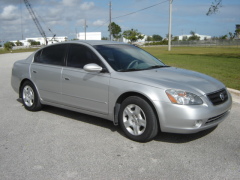
Lower Purchase Price: Obviously, older Altimas generally have lower purchase prices compared to newer models. This initial cost savings can be attractive for those on a tighter budget.
Potentially Lower Insurance Costs: Older cars often have lower insurance premiums compared to newer ones, adding to the savings.
Simpler Technology: Some people prefer the simplicity of older car technology. It might be easier to understand and repair without the complexity of newer electronic systems.
Potentially Less Depreciation: Since older cars have already undergone substantial depreciation, they might not lose value as rapidly as a newer car would.
Generous Cabin Space: Older Altimas typically offer ample space for both front and rear passengers, providing a comfortable ride for all occupants.
Decent Cargo Capacity: The trunk space in is generally sufficient for everyday use and luggage for trips.
Smooth Ride: Altimas provide a smooth and comfortable ride, particularly on highways and city roads.
Balanced Handling: They tend to offer reasonable handling and maneuverability, suitable for daily driving needs.
Reasonable Fuel Efficiency: Older Altima models deliver decent fuel economy for their time, especially with the four-cylinder engines.
Quiet Cabin: Generally, these cars maintain a relatively quiet cabin, enhancing the overall comfort during drives.
Older Nissan Altima Cons
Higher Maintenance Costs: Older cars generally require more frequent maintenance and might have parts that need replacement due to wear and tear. This can lead to higher repair costs over time and possibly offset the upfront cost savings.
Potentially Outdated Safety Features: An older Altima might lack modern safety features, putting occupants at a disadvantage in terms of safety compared to newer vehicles equipped with advanced safety technology. For example, antilock brakes were optional until the 2008 model.
Fuel Efficiency and Performance: Older cars might not be as fuel-efficient or perform as well as newer models, especially in terms of power, handling, and overall driving experience.
Limited Warranty and Support: An older Altima might not have any remaining warranty coverage, leaving owners responsible for all repair costs. Additionally, finding support or parts for older models might become challenging as they age.
Limited Adjustability: Some older models might have limited adjustability in seating, potentially impacting comfort on longer drives.
Smaller than Contemporary Competitors: While the space is adequate, newer models in the midsize sedan segment might offer more roominess.
Potential Suspension Wear: With age, the suspension might show signs of wear, leading to a less refined driving experience and potential noise issues.
Potential Interior Wear: Over time, interior materials might show signs of wear, affecting the overall comfort and aesthetic appeal.
 By Josh Rosenberg
By Josh Rosenberg